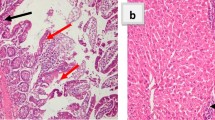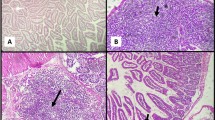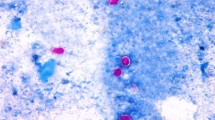Abstract
Cryptosporidiosis is an opportunistic, globally distributed parasitic disease. Whereas Cryptosporidium causes asymptomatic infection and diarrhea in healthy people, it may lead to severe illness in immunocompromised individuals. Limited, effective therapeutic alternatives are available against cryptosporidiosis in those categories of patients. So, we are in urgent need of better drugs for the treatment of cryptosporidiosis. Fifty male Swiss albino mice were used. Mice were grouped into five groups of ten mice each. Group I was left uninfected, and four groups were infected with 1000 oocysts of cryptosporidium. The first infected group was left untreated. The remaining three-infected groups received nitazoxanide (NTZ), eugenol, and eugenol + NTZ, respectively, on the 6th day post infection (dpi) for five days. Mice were sacrificed on the 30th dpi. The efficacy of treatment was evaluated using parasitological, biochemical, and histopathological parameters. Combination therapy of eugenol with NTZ caused a significant reduction of the number of oocysts secreted in stool and improved cryptosporidiosis-induced liver injury manifested by the restoration of normal levels of liver enzymes (ALT and AST). Treatment with eugenol-NTZ combination maintained a well-balanced antioxidant status, as evidenced by a reduced level of nitric oxide (NO) and increased antioxidant Superoxide dismutase (SOD) enzyme activity. Moreover, the combination of eugenol with NTZ resulted in the restoration of the normal morphology of intestinal villi, crypts, and muscularis mucosa. Based on the findings extracted from the present work, we can conclude that eugenol is a complementary therapeutic when used with NTZ in the treatment of cryptosporidiosis. The addition of eugenol to NTZ in the treatment of cryptosporidiosis synergized the effect of NTZ, causing a greater reduction of the number of shedded oocysts, improving liver enzyme levels, and restoring normal intestinal pathology. Therefore, we presume that eugenol's antioxidant capacity accounts for the protective effect seen in the current study. We suggest eugenol as a supplemental chemotherapeutic agent with good therapeutic potential and high levels of safety in the treatment of cryptosporidiosis based on the findings of the current study.





Similar content being viewed by others
References
Abubakar I, Aliyu SH, Arumugam C, Usman NK, Hunter PR (2007) Treatment of cryptosporidiosis in immunocompromised individuals: systematic review and meta-analysis. Br J Clin Pharmacol 63:387–393
Adler S, Widerström M, Lindh J, Lilja M (2017) Symptoms and risk factors of Cryptosporidium hominis infection in children: data from a large waterborne outbreak in Sweden. Parasitol Res 116:2613–2618
Anderson BC (1985) Moist heat inactivation of Cryptosporidium sp. Am J Public Health 75:1433–1434
Archer A, Deepika H, Negi P (2012) Antibacterial activity of eugenol and peppermint oil in model food systems. J Essent Oil Res 24:1–6
Atia AF, Dawoud MM, El-Refai SA (2018) Effects of Echinacea purpurea on cryptosporidiosis in immunosuppressed experimentally infected mice. Med J Cairo Univ 86(6):3209–3222
Bhagat M, Sood S, Yadav A, Verma P, Manzoor N, Chakraborty D, Katoch R, Sangha N (2017) Alterations in oxidative stress parameters and its associated correlation with clinical disease on experimental Cryptosporidium parvum infection in Swiss albino mice. J Parasit Dis 41:707–712
Bouzid M, Hunter PR, Chalmers RM, Tyler KM (2013) Cryptosporidium pathogenicity and virulence. Clin Microbiol Rev 26:115–134
Bouzid M, Kintz E, Hunter PR (2018) Risk factors for Cryptosporidium infection in low and middle income countries: a systematic review and meta-analysis. PLoS Negl Trop Dis 12:e0006553
Carr A, Marriott D, Field A, Vasak E, Cooper DA (1998) Treatment of HIV-1-associated microsporidiosis and cryptosporidiosis with combination antiretroviral therapy. Lancet 351(9098):256–261. https://doi.org/10.1016/S0140-6736(97)07529-6
Clemente CM, Pineda T, Yepes LM, Upegui Y, Allemandi DA, Robledo SM, Ravetti S (2022) Eugenol carbonate activity against Plasmodium falciparum, Leishmania braziliensis, and Trypanosoma cruzi. Arch Pharm (Weinheim) 355:e2100432
de Souza IMM, Novaes RD, Gonçalves RV, Fialho FLB, Carvalho DT, de Souza TB, Dias DF, Lavorato SN, Souza RLM, Marques MJ, Castro AP (2022) In vitro and in silico evaluation of the schistosomicidal activity of eugenol derivatives using biochemical, molecular, and morphological tools. J Venom Anim Toxins Incl Trop Dis 28:e20210108
Dixon B, Parrington L, Cook A, Pintar K, Pollari F, Kelton D, Farber J (2011) The potential for zoonotic transmission of Giardia duodenalis and Cryptosporidium spp. from beef and dairy cattle in Ontario, Canada. Vet Parasitol 175:20–26
El-Kady AM, Ahmad AA, Hassan TM, El-Deek HEM, Fouad SS, Althagfan SS (2019) Eugenol, a potential schistosomicidal agent with anti-inflammatory and antifibrotic effects against Schistosoma mansoni, induced liver pathology. Infect Drug Resist 12:709–719
Elmahallawy EK, Elshopakey GE, Saleh AA, Agil A, El-Morsey A, El-Shewehy DMM, Sad AS, Yanai T, Abdo W (2020) S-Methylcysteine (SMC) Ameliorates intestinal, hepatic, and splenic damage induced by Cryptosporidium parvum infection via targeting inflammatory modulators and oxidative stress in swiss albino mice. Biomedicines 8(10):423
Fahmy A, Alshenawy A, El-Wakil E, Hegab A (2021) Efficacy of Cyperus rotundus extract against cryptosporidiosis and toxoplasmosis in murine infections. Egypt Pharmaceut J 20:242
Fayer R, Ungar B (1986) Cryptosporidium spp. and cryptosporidiosis. Microbiol Rev 50:458–483
Fayer R, Farley CA, Lewis EJ, Trout JM, Graczyk TK (1997) Potential role of the Eastern oyster, Crassostrea virginica, in the epidemiology of Cryptosporidium parvum. Appl Environ Microbiol 63:2086–2088
Fayer R, Morgan U, Upton SJ (2000) Epidemiology of Cryptosporidium: transmission, detection and identification. Int J Parasitol 30:1305–1322
Gaber M, Galal LAA, Farrag HMM, Badary DM, Alkhalil SS, Elossily N (2022) The effects of commercially available Syzygium aromaticum, Anethum graveolens, Lactobacillus acidophilus LB, and Zinc as alternatives therapy in experimental mice challenged with Cryptosporidium parvum. Infect Drug Resist 15:171–182
Gibney KB, O’Toole J, Sinclair M, Leder K (2017) Burden of disease attributed to waterborne transmission of selected enteric pathogens, Australia, 2010. Am J Trop Med Hyg 96:1400–1403
Gracenea M, Castaño S, Méndez J, Lucena F, Gómez MS (2018) Faecal contamination in public pools in Barcelona province: Cryptosporidium spp. and bacterial indicators. J Water Health 16:762–772
Hafez EN, Hamed WFAE (2021) The efficacy of citrus maxima peels aqueous extract against cryptosporidiosis in immunecompromised mice. Acta Parasitol 66:638–653
Halliwell B (1996) Antioxidants in human health and disease. Annu Rev Nutr 16:33–50
Henriksen SA, Pohlenz JFL (1981) Staining of cryptosporidia by a modified Ziehl–Neelsen technique. Acta Vet Scand 22:594
Hunter PR, Thompson RA (2005) The zoonotic transmission of Giardia and Cryptosporidium. Int J Parasitol 35:1181–1190
Islamuddin M, Chouhan G, Want MY, Ozbak HA, Hemeg HA, Afrin F (2016) Immunotherapeutic potential of eugenol emulsion in experimental visceral leishmaniasis. PLoS Negl Trop Dis 10:e0005011
Khalil IA, Troeger C, Rao PC, Blacker BF, Brown A, Brewer TG, Colombara DV, De Hostos EL, Engmann C, Guerrant RL (2018) Morbidity, mortality, and long-term consequences associated with diarrhoea from Cryptosporidium infection in children younger than 5 years: a meta-analyses study. Lancet Glob Health 6:e758–e768
Machado M, Dinis AM, Salgueiro L, Custódio JB, Cavaleiro C, Sousa MC (2011) Anti-Giardia activity of Syzygium aromaticum essential oil and eugenol: effects on growth, viability, adherence and ultrastructure. Exp Parasitol 127:732–739
Maggi P, Larocca AM, Quarto M, Serio G, Brandonisio O, Angarano G, Pastore G (2000) Effect of antiretroviral therapy on cryptosporidiosis and microsporidiosis in patients infected with human immunodeficiency virus type 1. Eur J Clin Microbiol Infect Dis 19(3):213–217. https://doi.org/10.1007/s100960050461
Majeed QA, El-Azazy OM, Abdou N-EM, Al-Aal ZA, El-Kabbany AI, Tahrani LM, AlAzemi MS, Wang Y, Feng Y, Xiao L (2018) Epidemiological observations on cryptosporidiosis and molecular characterization of Cryptosporidium spp. in sheep and goats in Kuwait. Parasitol Res 117:1631–1636
Marchese A, Barbieri R, Coppo E, Orhan IE, Daglia M, Nabavi SF, Izadi M, Abdollahi M, Nabavi SM, Ajami M (2017) Antimicrobial activity of eugenol and essential oils containing eugenol: a mechanistic viewpoint. Crit Rev Microbiol 43:668–689
Mead JR, Ilksoy N, You X, Belenkaya Y, Arrowood MJ, Fallon MT, Schinazi RF (1994) Infection dynamics and clinical features of cryptosporidiosis in SCID mice. Infect Immun 62:1691–1695
Miyazawa M, Hisama M (2001) Suppression of chemical mutagen-induced SOS response by alkylphenols from clove (Syzygium aromaticum) in the Salmonella typhimurium TA1535/pSK1002 umu test. J Agric Food Chem 49:4019–4025
Mousa N, Abdel-Razik A, El-Nahas H, El-Shazly A, Abdelaziz M, Nabih M, Hamed M, Eissa M, Effat N, Eldars W (2014) Cryptosporidiosis in patients with diarrhea and chronic liver diseases. The J Infect Dev Cties 8:1584–1590
Murakami K, Tanemura Y, Yoshino M (2003) Dipicolinic acid prevents the copper-dependent oxidation of low density lipoprotein. J Nutr Biochem 14:99–103
Nishikimi M, Appaji Rao N, Yagi K (1972) The occurrence of superoxide anion in the reaction of reduced phenazine methosulfate and molecular oxygen. Biochem Biophys Res Commun 46:849–854
Ogata M, Hoshi M, Urano S, Endo T (2000) Antioxidant activity of eugenol and related monomeric and dimeric compounds. Chem Pharm Bull (tokyo) 48:1467–1469
Petry F, Jakobi V, Tessema TS (2010) Host immune response to Cryptosporidium parvum infection. Exp Parasitol 126:304–309
Raja MC, Srinivasan V, Selvaraj S, Mahapatra S (2015) Eugenol: a versatile phytomedicine. Int J Pharm Pharm Sci 7:35–40
Rao J, Chen B, McClementsDJJArofs, (2019) Improving the efficacy of essential oils as antimicrobials in foods: mechanisms of action. Annu Rev Food Sci Technol 25(10):365–387
Ratty AK, Das NP (1988) Effects of flavonoids on nonenzymatic lipid peroxidation: structure-activity relationship. Biochem Med Metab Biol 39:69–79
Riella KR, Marinho RR, Santos JS, Pereira-Filho RN, Cardoso JC, Albuquerque-Junior RLC, Thomazzi SM (2012) 'Anti-inflammatory and cicatrizing activities of thymol, a monoterpene of the essential oil from Lippia gracilis, in rodents. J Ethnopharmacol 143:656–663
Savioli L, Smith H, ompson, A, (2006) Giardia and Cryptosporidium join the “Neglected Diseases Initiative. Trends Parasitol 22:203–208
Shoultz DA, de Hostos EL, Choy RK (2016) Addressing Cryptosporidium infection among young children in low-income settings: the crucial role of new and existing drugs for reducing morbidity and mortality. PLoS Negl Trop Dis 10(1):e0004242
Shrivastava AK, Kumar S, Smith WA, Sahu PS (2017) Revisiting the global problem of cryptosporidiosis and recommendations. Tropical Parasitology 7:8
Sparks H, Nair G, Castellanos-Gonzalez A, White AC (2015) Treatment of Cryptosporidium: What we know, gaps, and the way forward. Current Tropical Medicine Reports 2:181–187
Tasdemir D, Kaiser M, Demirci B, Demirci F, Baser KHC (2019) Antiprotozoal activity of Turkish Origanum onites essential oil and its components. Molecules 24(23):4421
Thoden J, Potthoff A, Bogner JR, Brockmeyer NH, Esser S, Grabmeier-Pfistershammer K, Haas B, Hahn K, Härter G, Hartmann M, Herzmann C, Hutterer J, Jordan AR, Lange C, Mauss S, Meyer-Olson D, Mosthaf F, Oette M, Reuter S, Rieger A, Rosenkranz T, Ruhnke M, Schaaf B, Schwarze S, Stellbrink HJ, Stocker H, Stoehr A, Stoll M, Träder C, Vogel M, Wagner D, Wyen C, Hoffmann C (2013) Therapy and prophylaxis of opportunistic infections in HIV-infected patients: a guideline by the German and Austrian AIDS societies (DAIG/ÖAG) (AWMF 055/066). Infection 41(Suppl 2):S91-115
Undeğer U, Başaran A, Degen GH, Başaran N (2009) Antioxidant activities of major thyme ingredients and lack of (oxidative) DNA damage in V79 Chinese hamster lung fibroblast cells at low levels of carvacrol and thymol. Food Chem Toxicol 47:2037–2043
Zhang Y, Lee B, Thompson M, Glass R, Cama RI, Figueroa D, Gilman R, Taylor D, Stephenson C (2000) Lactulose-mannitol intestinal permeability test in children with diarrhea caused by rotavirus and Cryptosporidium. Diarrhea Working Group. Peru J Pediatr Gastroenterol Nutr 31:16–21
Funding
This research did not receive any specific grant from funding agencies in the public, commercial, or not-for-profit sectors.
Author information
Authors and Affiliations
Corresponding author
Ethics declarations
Conflict of interest
The authors declare that they have no known competing financial interests or personal relationships that could have appeared to influence the work reported in this paper.
Additional information
Publisher's Note
Springer Nature remains neutral with regard to jurisdictional claims in published maps and institutional affiliations.
Rights and permissions
Springer Nature or its licensor (e.g. a society or other partner) holds exclusive rights to this article under a publishing agreement with the author(s) or other rightsholder(s); author self-archiving of the accepted manuscript version of this article is solely governed by the terms of such publishing agreement and applicable law.
About this article
Cite this article
Gattan, H.S., Fouad, S.S., Ellisy, R.A. et al. Eugenol: effective complementary treatment for cryptosporidiosis in experimentally infected mice. J Parasit Dis (2024). https://doi.org/10.1007/s12639-024-01676-0
Received:
Accepted:
Published:
DOI: https://doi.org/10.1007/s12639-024-01676-0




